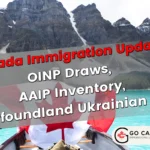Aug 2025 Canada updates: IRCC Express Entry Strategy, IRCC prioritizes Francophone, Healthcare, Trades, and Education draws, provincial nominees shift to tech, PEI recruits 20 US healthcare workers, Alberta boosts Asian tourism, and TFWs in healthcare soar with 60% PR transition. Go Canada Services offers expert support.
Canada Aug 2025 Immigration Updates: IRCC Express Entry Strategy, Provincial Nominee Trends, PEI Healthcare Recruitment, Alberta Tourism Mission, and TFW Healthcare Surge
IRCC Express Entry Strategy Introduction
Aug 2025 brings pivotal updates to Canada’s immigration and economic landscape, reflecting targeted strategies to address labour shortages, integration, and economic growth.
IRCC’s Express Entry strategy prioritizes Francophone, Healthcare, Trades, and Education draws, provincial nominees shift to high-skilled tech roles, Prince Edward Island (PEI) recruits 20 US healthcare professionals, Alberta’s tourism minister targets Asian markets, and temporary foreign workers (TFWs) in healthcare see a surge with high permanent residency (PR) transitions.
These align with the 2025–2027 Immigration Levels Plan (395,000 PRs, 673,650 temporary residents in 2025) and prior user queries on immigration policies, labour, and integration.
Go Canada Services, a trusted immigration firm since 2004, offers expert guidance. This article addresses the user’s Arabic query, integrating web and X sources for context.
IRCC’s Express Entry Strategy for 2025
IRCC’s 2025 Express Entry strategy, revealed via ATIP notes by Mandeep Lidher, emphasizes targeted draws to meet economic and linguistic goals. Key details:
- Details: IRCC issued 18,500 ITAs for Francophone candidates (NCLC 7+) to meet an 8.5% target outside Quebec, with CRS cut-offs as low as 379 (March 21, 2025). Quotas include 8,000 ITAs for Healthcare (CRS 475–510), 3,300 for Trades (CRS ~500+), and 3,000 for Education (CRS 479). General draws alternate with category-based rounds, but Canadian Experience Class (CEC) cut-offs remain high (518–547). Francophone draws may slow, with potential processing delays in late 2025 due to a 2.19 million application backlog.
- Context: The strategy aligns with the 2025–2027 plan, prioritizing Federal Economic Priorities (healthcare, trades, education) and In-Canada Focus (CEC, PNP). X posts from @MandeepLidher highlight the memo’s transparency. Healthcare and Trades draws address labour shortages (15% doctor shortage, 7% trades vacancy rate), while Education targets teachers and childcare workers.
- Impact: Applicants should optimize CRS scores (510+ for CEC, 450–479 for category-based) via language proficiency (CLB 9+, NCLC 7+), Canadian work experience, or PNP nominations (+600 CRS points). Francophone applicants benefit from lower thresholds but should apply early.
For Express Entry support, contact Go Canada Services’ Free Assessment.
Provincial Nominees Shift to High-Skilled Tech Jobs
A Statistics Canada and IRCC study reveals evolving employment trends among provincial nominees. Key points:
- Details: The 2021 Census shows 15.7% of nominees worked as computer professionals (vs. 4.2% in 2011), matching Canadian-born professionals at 25% but overrepresented in lower-skilled jobs and underrepresented in trades. Provinces like Ontario and British Columbia see higher tech employment, driven by PNP streams like OINP’s Tech Draw (1,200 nominations in 2025).
- Context: Canada’s tech sector grew 6.3% annually (2020–2024), with 182,000 job vacancies in Q1 2025. Nominees benefit from PNPs (55,000 slots in 2025) but face integration barriers (11.2% unemployment for recent immigrants). X posts from @StatCan_eng note credential recognition challenges.
- Impact: Nominees should target tech-focused PNPs (e.g., BC PNP Tech Stream) and secure high-demand NOC codes (e.g., 21211 for data scientists). Upskilling via bridging programs (e.g., ACCES Employment) can boost employability.
For PNP support, explore Go Canada Services’ Permanent Residency Services.
PEI Strengthens Healthcare System with US Professionals
PEI bolsters its healthcare workforce through international recruitment. Key findings:
- Details: Since January 2025, PEI recruited 20 US healthcare professionals (physicians, nurse practitioners, nurses, lab technologists) via the Physician Services Agreement and allied health incentives. This builds on 18 months of workforce growth, addressing a 12% healthcare vacancy rate.
- Context: PEI’s aging population (19% over 65) drives demand, with 1,500 healthcare workers needed by 2030. The Atlantic Immigration Program (AIP) and PNP (400 slots in 2025) support recruitment. X posts from @PEIGov praise the initiative’s impact on rural care.
- Impact: US professionals should leverage AIP or PNP streams, ensuring credentials align with Canadian standards (e.g., MCC for physicians). Applicants must act fast to secure limited slots.
For healthcare immigration support, visit Go Canada Services’ Work Permit Services.
Alberta’s Tourism Mission to Asia
Alberta aims to boost tourism through a strategic mission to Asia. Key insights:
- Details: Tourism Minister Andrew Boitchenko’s mission to South Korea and Japan (August 28, 2025) leverages WestJet’s Calgary–Incheon/Narita flights to promote Alberta’s attractions. The goal is $25 billion in visitor spending, targeting Asia’s 1.2 million annual visitors to Canada.
- Context: Tourism contributes 4.5% to Alberta’s GDP, with 2024 visitor spending at $20 billion. The Air Access Program drives 10% growth in international arrivals. X posts from @TravelAlberta highlight Asia’s market potential.
- Impact: Tourism workers (e.g., hospitality, guides) should pursue work permits via the International Mobility Program (IMP), which saw 302,000 admissions in H1 2025. PR pathways like AAIP’s Tourism and Hospitality Stream are viable.
For tourism work permit support, contact Go Canada Services’ Contact Page.
Surge in TFWs in Healthcare with High PR Transition
A Statistics Canada study highlights TFW growth in healthcare. Key findings:
- Details: TFWs in healthcare rose from 3,200 (2000) to 57,500 (2022), with 60% of the 2010–2014 cohort transitioning to PR within five years. India overtook the Philippines as the top source since 2017, with Ontario, Quebec, and BC hosting most workers. Retention in healthcare post-PR is high (85%).
- Context: Healthcare shortages (15% doctor shortage, 10% nurse vacancy rate) drive TFW reliance, despite cuts to 140,000 total TFWs in 2025. X posts from @Tablesalt13 question urban labour shortage claims. The 2025–2027 plan prioritizes healthcare PR transitions.
- Impact: TFWs should target PR via CEC or PNPs (e.g., AAIP Healthcare Pathway, CRS 56). Language skills (CLB 7+) and Canadian experience boost chances.
For TFW PR transition support, explore Go Canada Services’ Free Assessment.
Broader Context from Prior Queries
- Fewer Arrivals: 214,520 fewer students/workers in H1 2025 due to 10% study permit cuts and tighter work permit rules.
- Yukon Nominee Program: Expanded to 282 slots, prioritizing healthcare and French speakers.
- Start-Up Visa Delays: 52-month processing, 73–85% refusals, with spots cut to 1,000 by 2027.
- Francophone Immigration: 12% PR target by 2029, with 18,500 ITAs in 2025.
- Refugee Surge: 11,163 claims in July 2025, with a 291,975-case backlog.
- Poilievre’s Criticism: Slams Liberal overshoots (105,000 TFWs vs. 82,000 cap) and proposes a 250,000 cap.
- TFWP Underclass: 140,000 workers risk exclusion; PR pathways needed.
- National Service: 70% support for integration via civilian service.
Other Key Updates
- Alberta AAIP Draws: 683 invitations (August 7–12): 63 Healthcare Express Entry (CRS 56), 39 Healthcare Non-Express Entry (score 53), 581 Opportunity Stream (score 70).
- Biometrics for Citizenship: Mandatory fingerprints/facial recognition start 2026–2027 ($85–$170).
- Afghan Refugee Crisis: 3,000 Afghans in Tajikistan face deportation; IRCC collaborates with UNHCR.
- American Refugee Claims: 245 claims in H1 2025, driven by transgender issues.
- Immigrant Unemployment: 11.2% for recent immigrants vs. 6.2% for Canadian-born (July 2025).
- Poilievre’s Deportation Policy: Immediate deportation for criminal non-citizens, announced August 20, 2025.
- Express Entry Medical Exams: Mandatory upfront exams start August 21, 2025 ($140–$280).
- Newfoundland Draws: 231 invitations on August 13 (180 NLPNP, 51 AIP).
- Data Transparency: Carney administration withholds data since May 2025.
- Refusal Rates: Study permits (65.4%) and visitor visas (50%) face high refusals.
Immigration and Settlement Strategies
- Express Entry Applicants: Boost CRS scores (510+ for CEC, 450–479 for category-based) with CLB 9+, NCLC 7+, or PNP nominations. Francophones should apply early for low-CRS draws (379–428).
- PNP Applicants: Target tech-focused streams (e.g., OINP, BC PNP) and upskill for high-demand NOC codes (e.g., 21211).
- Healthcare TFWs: Pursue PR via CEC or PNPs like AAIP Healthcare Pathway; maintain Canadian experience and CLB 7+.
- Tourism Workers: Secure IMP work permits for Alberta’s tourism sector; explore AAIP Tourism and Hospitality Stream.
- US Healthcare Professionals: Apply via PEI PNP or AIP; ensure credential alignment with MCC or CNO standards.
For tailored strategies, start with Go Canada Services’ Free Assessment.

Frequently Asked Questions
- What is IRCC’s 2025 Express Entry strategy?
IRCC prioritizes 18,500 Francophone ITAs (8.5% target), 8,000 Healthcare, 3,300 Trades, and 3,000 Education ITAs, with CEC cut-offs in the high 500s and potential late-2025 delays. - How are provincial nominees’ jobs shifting?
Nominees increasingly fill tech roles (15.7% computer professionals in 2021 vs. 4.2% in 2011), with less presence in trades and more in lower-skilled jobs. - What is PEI’s healthcare recruitment initiative?
PEI recruited 20 US professionals (physicians, nurses, technologists) since January 2025, using the Physician Services Agreement and incentives. - What is Alberta’s tourism mission to Asia?
Minister Boitchenko’s August 28 mission to South Korea and Japan promotes Alberta via WestJet flights, targeting $25 billion in visitor spending. - How have TFWs in healthcare changed?
TFWs in healthcare rose from 3,200 (2000) to 57,500 (2022), with 60% of 2010–2014 cohorts transitioning to PR, led by India.
Why Choose Go Canada Services?
Go Canada Services excels in navigating Canada’s immigration pathways, offering solutions for Permanent Residency, Work Permits, Study Permits, and Family Sponsorship. Their regulated consultants ensure compliance with IRCC and provincial requirements. Start with a Free Assessment or contact them at Go Canada Services’ Contact Page.
Call to Action
Begin your journey to Canada with Go Canada Services. Schedule a consultation for immigration, work, or settlement support. Satisfied with their services? Leave a review on Google.


